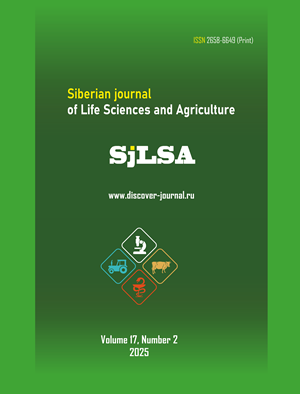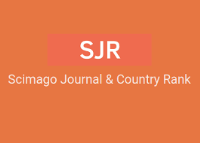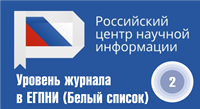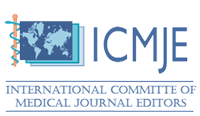Antibacterial activity of green synthesized silver nanoparticles using aqueous extract of Aeluropus litoralis and their anticancer and antioxidant properties
Аннотация
Background. The biosynthesis of nanoparticles using plant extracts offers an eco-friendly and cost-effective method for producing stable nanoparticles with various applications in medicine, agriculture, and environmental science.
Purpose. To investigate the ability of Aeluropus littoralis aqueous extract to biosynthesize silver nanoparticles (AgNPs) and of antibacterial activity, anticancer and antioxidant properties.
Materials and methods. A. littoralis aerial parts were washed, dried, and ground. Extract was prepared by boiling 7 g in 100 mL water, filtered, and dried. Aelu-AgNPs were biosynthesized by mixing extract with AgNO₃, incubating until color change, then centrifuging and washing. Nanoparticles were characterized by UV-Vis, FTIR, XRD, SEM, EDX, and zeta potential. Antibacterial activity was tested against MDR bacteria using agar diffusion, MIC, and MBC assays. Cytotoxicity was evaluated with MTT on cancer and normal cells. Antioxidant activity was measured by DPPH assay. Data analysis used SPSS and GraphPad Prism.
Results. The aqueous extract of A. littoralis operated as a reducing agent for AgNO3, resulting in the formation of AgNPs (Aelu-AgNPs), which was confirmed by spectroscopy at the greatest peak of 410 nm. Based on FESEM analysis, the Aelu-AgNPs were around 41.43 nm in size. The XRD study demonstrated a face-centered cubic structure, whereas zeta potential assessment suggested significant stability at -40.4 mV. Pseudomonas aeruginosa, Citrobacter freundii, Proteus mirabilis, Enterobacter cloacae, Escherichia coli, Providencia rettgeri, Klebsiella pneumoniae, Staphylococcus aureus, S. haemolyticus, S. epidermidis, S. hominis, and Enterococcus faecium were all proven to be susceptible to the Aelu-AgNPs. Among the bacteria tested, P. mirabilis showed the most sensitivity, with a 19.5 mm inhibition zone. The MIC ranged from 62.5 to 7.8 µg/ml and the MBC from 62.5 to 15.6 µg/ml for all the bacterial isolates that were examined. The results showed that the Aelu-AgNPs had a potential antioxidant activity higher than ascorbic acid at a concentration of 12.5 μg/ml. The MTT assay validated superior efficacy in inhibiting the A375 cancer cell line with an IC50 of 71.04 μg/ml, in contrast to 148.6 μg/ml of the normal cell line (HdFn).
Conclusion: The biosynthesized silver nanoparticles obtained from A. littoralis extract exhibit potential as antibacterial, antioxidant, and anticancer agents.
EDN: RHIAYC
Скачивания
Литература
Adebayo-Tayo, B. C., Ekundayo-Obaba, O., & Falodun, O. I. (2020). Antimicrobial potential of bioactive metabolites and silver nanoparticles from Bacillus spp. and of some antibiotics against multidrug resistant Salmonella spp. Turkish Journal of Pharmaceutical Sciences, 17(5), 511-522. https://doi.org/10.4274/tjps.galenos.2019.46548 EDN: https://elibrary.ru/CQLULG
Catalano, A., Iacopetta, D., Ceramella, J., Scumaci, D., Giuzio, F., Saturnino, C., & Sinicropi, M. S. (2022). Multidrug resistance (MDR): A widespread phenomenon in pharmacological therapies. Molecules, 27(3), 616-634. https://doi.org/10.3390/molecules27030616 EDN: https://elibrary.ru/HEJIDP
Khalil, M. A., El Maghraby, G. M., Sonbol, F. I., Allam, N. G., Ateya, P. S., & Ali, S. S. (2021). Enhanced efficacy of some antibiotics in presence of silver nanoparticles against multidrug resistant Pseudomonas aeruginosa recovered from burn wound infections. Frontiers in Microbiology, 12, 1-20. https://doi.org/10.3389/fmicb.2021.648560 EDN: https://elibrary.ru/LNGKRA
Mikhailova, E. O. (2020). Silver nanoparticles: Mechanism of action and probable bio-application. Journal of Functional Biomaterials, 11(4), 84-110. https://doi.org/10.3390/jfb11040084 EDN: https://elibrary.ru/BHRVSB
Bruna, T., Maldonado-Bravo, F., Jara, P., & Caro, N. (2021). Silver nanoparticles and their antibacterial applications. International Journal of Molecular Sciences, 22(13), 7202-7223. https://doi.org/10.3390/ijms22137202 EDN: https://elibrary.ru/ZDZBXM
Zhang, X. F., Liu, Z. G., Shen, W., & Gurunathan, S. (2016). Silver nanoparticles: Synthesis, characterization, properties, applications, and therapeutic approaches. International Journal of Molecular Sciences, 17(9), 1534-1568. https://doi.org/10.3390/ijms17091534 EDN: https://elibrary.ru/XTTASF
Swanner, J., Fahrenholtz, C. D., Tenvooren, I., Bernish, B. W., Sears, J. J., Hooker, A., Furdui, C. M., Alli, E., Li, W., Donati, G. L., Cook, K. L., Vidi, P. A., & Singh, R. (2019). Silver nanoparticles selectively treat triple-negative breast cancer cells without affecting non-malignant breast epithelial cells in vitro and in vivo. FASEB Bio Advances, 1(10), 639-661.
Khalil, M. A., El-Shanshoury, A. E. R. R., Alghamdi, M. A., Alsalmi, F. A., Mohamed, S. F., Sun, J., & Ali, S. S. (2022). Biosynthesis of silver nanoparticles by Marine actinobacterium Nocardiopsis dassonvillei and exploring their therapeutic potentials. Frontiers in Microbiology, 12, 1-15.
Parveen, K., Banse, V., & Ledwani, L. (2016). Green synthesis of nanoparticles: Their advantages and disadvantages. AIP Conference Proceedings, 1724(1).
Vishwanath, R., & Negi, B. (2021). Conventional and green methods of synthesis of silver nanoparticles and their antimicrobial properties. Current Research in Green and Sustainable Chemistry, 4, 1-12. https://doi.org/10.1016/j.crgsc.2021.100205 EDN: https://elibrary.ru/ZOITFI
Dahoumane, S. A., Mechouet, M., Wijesekera, K., Filipe, C. D., Sicard, C., Bazylinski, D. A., & Jeffryes, C. (2017). Algae-mediated biosynthesis of inorganic nanomaterials as a promising route in nanobiotechnology-a review. Green Chemistry, 19(3), 552-587. https://doi.org/10.1039/c6gc02346k EDN: https://elibrary.ru/YIXMMU
Alharbi, N. S., Alsubhi, N. S., & Felimban, A. I. (2022). Green synthesis of silver nanoparticles using medicinal plants: Characterization and application. Journal of Radiation Research and Applied Sciences, 15(3), 109-124. https://doi.org/10.1016/j.jrras.2022.06.012 EDN: https://elibrary.ru/PMPFXW
Sytar, O., Mbarki, S., Zivcak, M., & Brestic, M. (2018). The involvement of different secondary metabolites in salinity tolerance of crops. In Salinity Responses and Tolerance in Plants (pp. 21-48). Springer. https://doi.org/10.1007/978-3-319-90318-7_2 EDN: https://elibrary.ru/VBDWHK
Reddy, N. V., Li, H., Hou, T., Bethu, M. S., Ren, Z., & Zhang, Z. (2021). Phytosynthesis of silver nanoparticles using Perilla frutescens leaf extract: characterization and evaluation of antibacterial, antioxidant, and anticancer activities. International Journal of Nanomedicine, 1, 15-29.
Vijapur, L. S., Srinivas, Y., Desai, A. R., Gudigennavar, A. S., Shidramshettar, S. L., & Yaragattimath, P. (2023). Development of biosynthesized silver nanoparticles from Cinnamomum tamala for anti-oxidant, anti-microbial and anti-cancer activity. Journal of Research in Pharmacy, 27(2), 769-782.
CLSI. (2024). Performance standards for antimicrobial susceptibility testing, M100, 34th ed. Clinical and Laboratory Standards Institute.
Hussein, A. A., Albarazanchi, S. I., & Al-Shanon, A. F. (2020). Evaluation of anticancer potential for L-glutaminase purified from Bacillus subtilis. International Journal of Pharmaceutical Research, 12(1), 293-299.
Al-Saffar, A. Z., Al-Shanon, A. F., Al-Brazanchi, S. L., Sabry, F. A., Hassan, F., & Hadi, N. A. (2017). Phytochemical analysis, antioxidant and cytotoxic potentials of Pelargonium graveolens extract in human breast adenocarcinoma (MCF-7) cell line. Asian Journal of Biochemistry, 12(1), 16-26.
Dada, A. O., Inyinbor, A. A., Idu, E. I., Bello, O. M., Oluyori, A. P., Adelani-Akande, T. A., Okunola, A. A., & Dada, O. (2018). Effect of operational parameters, characterization and antibacterial studies of green synthesis of silver nanoparticles using Tithonia diversifolia. PeerJ, 6, 1-17.
Chand, K., Cao, D., Fouad, D. E., Shah, A. H., Dayo, A. Q., Zhu, K., Lakhan, M. N., Mehdi, G., & Dong, S. (2020). Green synthesis, characterization and photocatalytic application of silver nanoparticles synthesized by various plant extracts. Arabian Journal of Chemistry, 13(11), 8248-8261. https://doi.org/10.1016/j.arabjc.2020.01.009 EDN: https://elibrary.ru/VUOGGA
Jain, N., Jain, P., Rajput, D., & Patil, U. K. (2021). Green synthesized plant-based silver nanoparticles: Therapeutic prospective for anticancer and antiviral activity. Micro and Nano Systems Letters, 9(1), 1-24. https://doi.org/10.1186/s40486-021-00131-6 EDN: https://elibrary.ru/FOSWMC
Salleh, A., Naomi, R., Utami, N. D., Mohammad, A. W., Mahmoudi, E., Mustafa, N., & Fauzi, M. B. (2020). The potential of silver nanoparticles for antiviral and antibacterial applications: A mechanism of action. Nanomaterials, 10(8), 1-20. https://doi.org/10.3390/nano10081566 EDN: https://elibrary.ru/TCWRJZ
Raja, S., Ramesh, V., & Thivaharan, V. (2017). Green biosynthesis of silver nanoparticles using Calliandra haematocephala leaf extract, their antibacterial activity and hydrogen peroxide sensing capability. Arabian Journal of Chemistry, 10, 253-261.
Corciovă, A., Mircea, C., Burlec, A. F., Fifere, A., Moleavin, I. T., Sarghi, A., Tuchiluș, C., Ivănescu, B., & Macovei, I. (2022). Green synthesis and characterization of silver nanoparticles using a Lythrum salicaria extract and in vitro exploration of their biological activities. Life, 12(10), 1643-1659.
Kalpana, D., Han, J. H., Park, W. S., Lee, S. M., Wahab, R., & Lee, Y. S. (2019). Green biosynthesis of silver nanoparticles using Torreya nucifera and their antibacterial activity. Arabian Journal of Chemistry, 12(7), 1722-1732.
Elumalai, D., Hemavathi, M., Deepaa, C. V., & Kaleena, P. K. (2017). Evaluation of phytosynthesised silver nanoparticles from leaf extracts of Leucas aspera and Hyptis suaveolens and their larvicidal activity against malaria, dengue and filariasis vectors. Parasite Epidemiology and Control, 2(4), 15-26.
Serunting, M. A., Zulfikar, M. A., Setyorini, D. A., Rizki, W. O. S., Kurniawan, R., & Setiyanto, H. (2024). Facile sunlight-irradiation mediated green synthesis of highly stable silver nanoparticles using Archidendron bubalinum pods extract for antibacterial activity application. Case Studies in Chemical and Environmental Engineering, 10, 1-12. https://doi.org/10.1016/j.cscee.2024.100811 EDN: https://elibrary.ru/NBCFTF
Naveed, M., Batool, H., Rehman, S. U., Javed, A., Makhdoom, S. I., Aziz, T., Mohamed, A. A., Sameeh, M. Y., Almalki, A. A., Alamri, A. S., & Alhomrani, M. (2022). Characterization and evaluation of the antioxidant, antidiabetic, anti-inflammatory, and cytotoxic activities of silver nanoparticles synthesized using Brachychiton populneus leaf extract. Processes, 10(8), 1521-1539. https://doi.org/10.3390/pr10081521 EDN: https://elibrary.ru/FEXTOS
Tufail, M. S., Liaqat, I., Andleeb, S., Naseem, S., Zafar, U., Sadiqa, A., Liaqat, I., Ali, N. M., Bibi, A., Arshad, N., & Saleem, G. (2022). Biogenic synthesis, characterization and antibacterial properties of silver nanoparticles against human pathogens. Journal of Oleo Science, 71(2), 257-265. https://doi.org/10.5650/jos.ess21291 EDN: https://elibrary.ru/YCISAT
Shareef, A. A., Farhan, F. J., & Alriyahee, F. A. A. (2024). Green Synthesis of Silver Nanoparticles Using Aqueous Extract of Typha domingensis Pers. Pollen (qurraid) and Evaluate its Antibacterial Activity. Baghdad Science Journal, 21(1), 28-40.
Surega, R., Anita, B., Ramakrishnan, S., Gunasekaran, K., & Nakkeran, S. (2020). Synthesis and characterization of AgNps using plant extracts. International Journal of Current Microbiology and Applied Sciences, 9, 1939-1947. https://doi.org/10.20546/ijcmas.2020.902.221 EDN: https://elibrary.ru/DVCFTH
Shareef, A. A., Hassan, Z. A., Kadhi, M. A., & Al-Mussawi, A. A. (2022). Antibacterial Activity of Silver Nanoparticles Synthesized by Aqueous Extract of Carthamus oxycantha M. Bieb. Against Antibiotics Resistant Bacteria. Baghdad Science Journal, 19(3), 460-468. https://doi.org/10.21123/BSJ.2022.19.3.0460 EDN: https://elibrary.ru/HDLJFK
Shaaban, M. T., Zayed, M., & Salama, H. S. (2023). Antibacterial potential of bacterial cellulose impregnated with green synthesized silver nanoparticle against S. aureus and P. aeruginosa. Current Microbiology, 80(2), 75-84. https://doi.org/10.1007/s00284-023-03182-7 EDN: https://elibrary.ru/IJDQXR
Qin, W., Wang, C. Y., Ma, Y. X., Shen, M. J., Li, J., Jiao, K., Tay, F. R., & Niu, L. N. (2020). Microbe‐mediated extracellular and intracellular mineralization: environmental, industrial, and biotechnological applications. Advanced Materials, 32(22), 1-39. https://doi.org/10.1002/adma.201907833 EDN: https://elibrary.ru/PVAAEA
Yassin, M. T., Mostafa, A. A. F., Al-Askar, A. A., & Al-Otibi, F. O. (2022). Synergistic antibacterial activity of green synthesized silver nanomaterials with colistin antibiotic against multidrug-resistant bacterial pathogens. Crystals, 12(8), 1-20. https://doi.org/10.3390/cryst12081057 EDN: https://elibrary.ru/OCNPZL
Farhan, F. J., & Shareef, A. A. (2024). Biosynthesis of silver nanoparticles by extracellular metabolites of marine Kocuria flava and investigated its role in enhancing of antibacterial activity of ciprofloxacin. Baghdad Science Journal, 22(1), 1-20.
Abdellatif, A. A., Alhathloul, S. S., Aljohani, A. S., Maswadeh, H., Abdallah, E. M., Musa, K. H., & ElHamd, M. A. (2022). Green synthesis of silver nanoparticles incorporated aromatherapies utilized for their antioxidant and antimicrobial activities against some clinical bacterial isolates. Bioinorganic Chemistry and Applications, 2022(1), 2432758.
Choi, J. S., Jung, H. C., Baek, Y. J., Kim, B. Y., Lee, M. W., Kim, H. D., & Kim, S. W. (2021). Antibacterial activity of green-synthesized silver nanoparticles using Areca catechu extract against antibiotic-resistant bacteria. Nanomaterials, 11(1), 205-221. https://doi.org/10.3390/nano11010205 EDN: https://elibrary.ru/KVYFZO
Audtarat, S., Hongsachart, P., Dasri, T., Chio-Srichan, S., Soontaranon, S., Wongsinlatam, W., & Sompech, S. (2022). Green synthesis of silver nanoparticles loaded into bacterial cellulose for antimicrobial application. Nanocomposites, 8(1), 34-46. https://doi.org/10.1080/20550324.2022.2055375 EDN: https://elibrary.ru/MPSWPX
Hamid, M. K., Ahmed, M. E., & Huseen, D. A. (2024). Biosynthesis of Silver Nanoparticles by Pseudomonas aeruginosa and Evaluation of Their Antibacterial Activity and Cytotoxicity Assay Properties. Iraqi Journal of Medical Sciences, 22(1), 154-163.
Hamdi, O. H., Saadedin, S. M., & Al-Zaidi, I. H. (2021). Green biosynthesis of silver nanoparticles using gallium aparine green part extract and anti-skin cancer activity. Medico Legal Update, 21(2), 908-913. https://doi.org/10.37506/mlu.v21i2.2799 EDN: https://elibrary.ru/VEJLUE
Dawood, H. A., & Ahmed, A. S. (2021). Assessment on cytotoxicity of conjugation galardin (GM6001) with AG-PEG on A375 cell line. Biochemical & Cellular Archives, 21(1), 2789-2799. EDN: https://elibrary.ru/WGZFJP
Palle, S. R., Penchalaneni, J., Lavudi, K., Gaddam, S. A., Kotakadi, V. S., & Challagundala, V. N. (2020). Green synthesis of silver nanoparticles by leaf extracts of Boerhavia erecta and spectral characterization and their antimicrobial, antioxidant ad cytotoxic studies on ovarian cancer cell lines. Letters in Applied Nano Bio Science, 9(3), 1165-1176.
Karunakaran, S., & Hari, R. (2022). Comparative antioxidant and anti-gout activities of Citrullus colocynthis loaded fruit silver nanoparticles with its ethanolic extract. Avicenna Journal of Medical Biotechnology, 14(4), 303-309. https://doi.org/10.18502/ajmb.v14i4.10485 EDN: https://elibrary.ru/KWFDCP
Просмотров аннотации: 120
Copyright (c) 2025 Alaa M. Alrudainy, Ali Aboud Shareef

Это произведение доступно по лицензии Creative Commons «Attribution-NonCommercial-NoDerivatives» («Атрибуция — Некоммерческое использование — Без производных произведений») 4.0 Всемирная.

























































